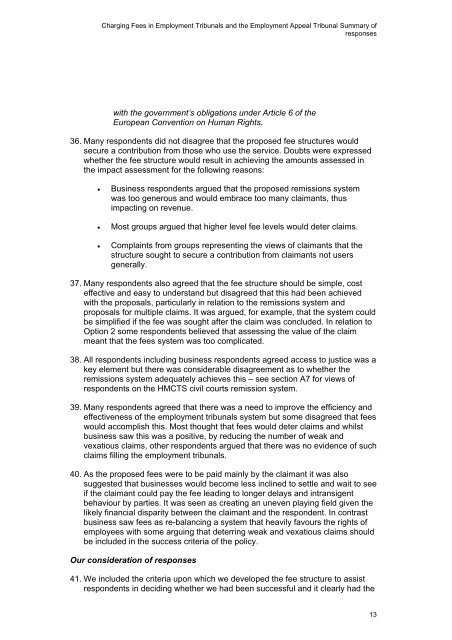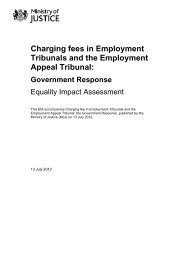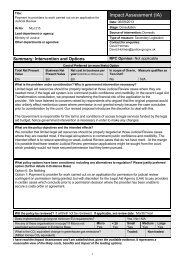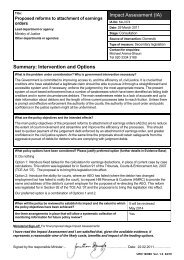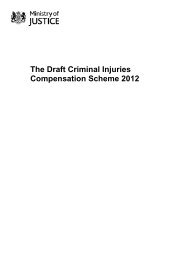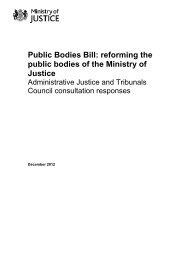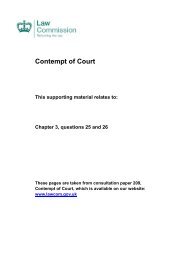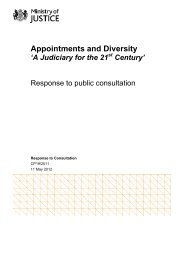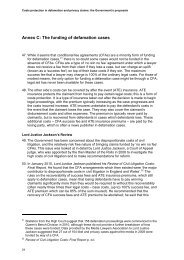Charging Fees in Employment Tribunals and the ... - Ministry of Justice
Charging Fees in Employment Tribunals and the ... - Ministry of Justice
Charging Fees in Employment Tribunals and the ... - Ministry of Justice
Create successful ePaper yourself
Turn your PDF publications into a flip-book with our unique Google optimized e-Paper software.
<strong>Charg<strong>in</strong>g</strong> <strong>Fees</strong> <strong>in</strong> <strong>Employment</strong> <strong>Tribunals</strong> <strong>and</strong> <strong>the</strong> <strong>Employment</strong> Appeal Tribunal Summary <strong>of</strong>responseswith <strong>the</strong> government’s obligations under Article 6 <strong>of</strong> <strong>the</strong>European Convention on Human Rights.36. Many respondents did not disagree that <strong>the</strong> proposed fee structures wouldsecure a contribution from those who use <strong>the</strong> service. Doubts were expressedwhe<strong>the</strong>r <strong>the</strong> fee structure would result <strong>in</strong> achiev<strong>in</strong>g <strong>the</strong> amounts assessed <strong>in</strong><strong>the</strong> impact assessment for <strong>the</strong> follow<strong>in</strong>g reasons:Bus<strong>in</strong>ess respondents argued that <strong>the</strong> proposed remissions systemwas too generous <strong>and</strong> would embrace too many claimants, thusimpact<strong>in</strong>g on revenue.Most groups argued that higher level fee levels would deter claims.Compla<strong>in</strong>ts from groups represent<strong>in</strong>g <strong>the</strong> views <strong>of</strong> claimants that <strong>the</strong>structure sought to secure a contribution from claimants not usersgenerally.37. Many respondents also agreed that <strong>the</strong> fee structure should be simple, costeffective <strong>and</strong> easy to underst<strong>and</strong> but disagreed that this had been achievedwith <strong>the</strong> proposals, particularly <strong>in</strong> relation to <strong>the</strong> remissions system <strong>and</strong>proposals for multiple claims. It was argued, for example, that <strong>the</strong> system couldbe simplified if <strong>the</strong> fee was sought after <strong>the</strong> claim was concluded. In relation toOption 2 some respondents believed that assess<strong>in</strong>g <strong>the</strong> value <strong>of</strong> <strong>the</strong> claimmeant that <strong>the</strong> fees system was too complicated.38. All respondents <strong>in</strong>clud<strong>in</strong>g bus<strong>in</strong>ess respondents agreed access to justice was akey element but <strong>the</strong>re was considerable disagreement as to whe<strong>the</strong>r <strong>the</strong>remissions system adequately achieves this – see section A7 for views <strong>of</strong>respondents on <strong>the</strong> HMCTS civil courts remission system.39. Many respondents agreed that <strong>the</strong>re was a need to improve <strong>the</strong> efficiency <strong>and</strong>effectiveness <strong>of</strong> <strong>the</strong> employment tribunals system but some disagreed that feeswould accomplish this. Most thought that fees would deter claims <strong>and</strong> whilstbus<strong>in</strong>ess saw this was a positive, by reduc<strong>in</strong>g <strong>the</strong> number <strong>of</strong> weak <strong>and</strong>vexatious claims, o<strong>the</strong>r respondents argued that <strong>the</strong>re was no evidence <strong>of</strong> suchclaims fill<strong>in</strong>g <strong>the</strong> employment tribunals.40. As <strong>the</strong> proposed fees were to be paid ma<strong>in</strong>ly by <strong>the</strong> claimant it was alsosuggested that bus<strong>in</strong>esses would become less <strong>in</strong>cl<strong>in</strong>ed to settle <strong>and</strong> wait to seeif <strong>the</strong> claimant could pay <strong>the</strong> fee lead<strong>in</strong>g to longer delays <strong>and</strong> <strong>in</strong>transigentbehaviour by parties. It was seen as creat<strong>in</strong>g an uneven play<strong>in</strong>g field given <strong>the</strong>likely f<strong>in</strong>ancial disparity between <strong>the</strong> claimant <strong>and</strong> <strong>the</strong> respondent. In contrastbus<strong>in</strong>ess saw fees as re-balanc<strong>in</strong>g a system that heavily favours <strong>the</strong> rights <strong>of</strong>employees with some argu<strong>in</strong>g that deterr<strong>in</strong>g weak <strong>and</strong> vexatious claims shouldbe <strong>in</strong>cluded <strong>in</strong> <strong>the</strong> success criteria <strong>of</strong> <strong>the</strong> policy.Our consideration <strong>of</strong> responses41. We <strong>in</strong>cluded <strong>the</strong> criteria upon which we developed <strong>the</strong> fee structure to assistrespondents <strong>in</strong> decid<strong>in</strong>g whe<strong>the</strong>r we had been successful <strong>and</strong> it clearly had <strong>the</strong>13


